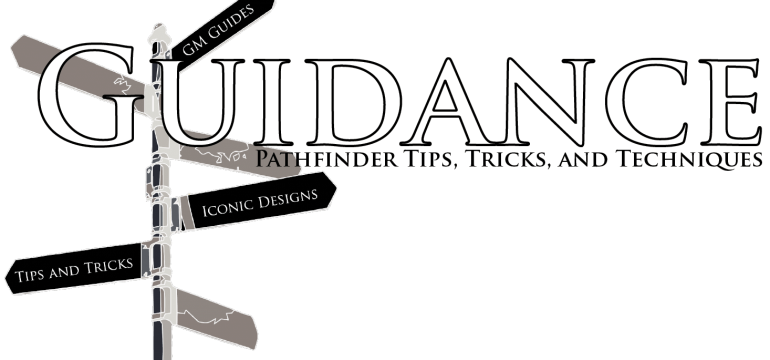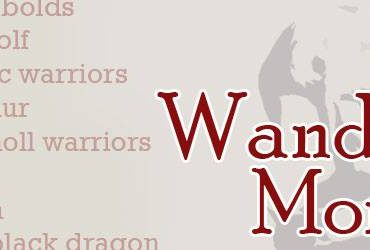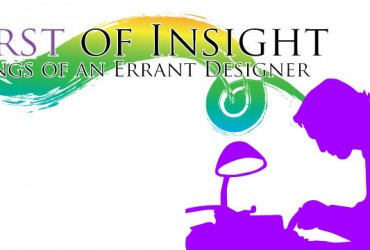As many of you know, I’m a fan of the non-human races. My logic is simple—I’m a human 24 hours a day, 7 days a week in the real world. I legitimately like being human, mind you, but during my “off time” when I’m playing a roleplaying game, I’d rather be playing a non-human.
This can sometimes get me a lot of weird labels, especially considering my favorite race in the Pathfinder Roleplaying Game is often squarely in in the fetish zone when you look a stone’s throw away from our community. (And sometimes not even that far; Code Switch blogger James Ballod has joked with me on a number of occasions that 95% of the non-sexualized kitsune in the Pathfinder Society are my characters.)
Still, even though it sometimes earns me weird looks, I like playing things that are different, and honestly—I don’t mind talking about that habit. Sometimes, I even go out of my way to talk about it. (Such as by writing a blog post on the topic that will likely be viewed by a couple of thousand people this month.) In one particular situation, I was chatting about the virtues of playing humans and nonhumans with another designer friend of mine. For the purpose of this article, we’ll call that person “D,” and I’m going to actively use gender neutral pronouns to refer to them. Maybe they’re male, maybe they’re female, maybe they identify as neither. YOU’LL NEVER KNOW!
So I was talking to D, and they mentioned to me that despite working on several different races for the Pathfinder Roleplaying Game throughout its history, they prefer to play humans because they prefer exploring ethnicity rather than race, and that one of the things they find boring in regards to writing and reading about new races is that they’re so cardboard. (Meaning they’re two-dimensional and lack depth.
Obviously, as someone who wrote about 160 pages on kitsune, nagaji, samsarans, and wayangs rather recently, I had a lot to say about this. But before I did, I asked D whether they minded if I shared my thoughts on the topic. Because when you’re talking about a conflict of opinion that doesn’t have grandiose consequences, I feel asking for permission is appropriate. D said sure, and so I shared my thoughts, which are the basis of today’s article.
You too have a choice, reader. Read on, or go back to Amazon—your choice. 😉
A Tradition of Blandness
So I think D had a good point when they said that races, as they’re so often presented in roleplaying games, are two-dimensional and lack depth. Even in the Pathfinder Roleplaying Game, races tend to be painted in broad strokes, their fine details filled in later (if at all). Let’s set aside the myriad of new races that we’ve gotten in Bestiaries and Campaign Settings and the like and focus on just the core races for a little bit—in 2007 when the Inner Sea Gazeteer was printed, each race got a standard write-up of roughly seven paragraphs, except humans, which got roughly two additional paragraphs for each of their major ethnic groups (that’s 11 extra articles in all, for a total of 22 extra paragraphs). Combined with the seven humanity originally got, we’re looking at a total of 28 paragraphs—literally four times as much as any other races. Elves of Golarion came out in 2008, a year before the Pathfinder Roleplaying Game, and Dwarves of Golarion soon followed. However, the “original” version of what is now the Inner Sea World Guide was published during the same year as Elves of Golarion, and if we’re really honest with ourselves, the way that Golarion is written, most of that Campaign Setting Guide is human support. The other races would also eventually get “of Golarion” books too, including humans of all races, though half-orcs and half-elves only got roughly a third of a book in the form of Bastards of Golarion, which actually only came out in the last two years or so.
As far as Pathfinder’s concerned, there has—always—been more words printed about humans than any other race, and this tradition is MUCH older than Pathfinder. It goes back throughout 3.5 into every major campaign setting that TSR and Dungeons & Dragons ever published. (The only exception—might—be Faerun; that setting was comparatively crazy about elves instead of humanity, but even they managed at least three different splatbooks focused on human controlled regions during 3.5.) Now, there are two big things to take away from this, both which are sort of a slippery slope. First, there’s the fact that publishers tend to write what sells, so to a certain degree we can surmise that humanity might simply sell better than other races. Along those same lines, however, is the fact that the races were not balanced equally in terms of their racial abilities in 3.5 (and by inheritance, Pathfinder), so it’s possible that the “human demand” was self-engineered. “We’ll make humans a little more powerful so people will want to play them. Oops, we over shot it and now most people want to play human. Guess we better write all these books about human ethnicities and cultures.”
It’s not the perfect theory, but hey, it works. However, I think there’s another tradition at play here besides good old fashioned capitalism, and this one goes back WAY farther into the game’s past.
Silly Kitsune, Ethnicity is for Humans!
So when I had this conversation with D, the big elephant in the room was the simple fact that if races seemed like cardboard, then we as writers are intrinsically at fault because we decide what’s said about those races. And if we’re being completely honest with ourselves, there is absolutely no reason that races other than humans could not have ethnic groups. Honestly, some of them do in Pathfinder (elves, dwarves, arguably gnomes). However, there is ONE little uncomfortable smidge that Pathfinder does in this regard that is a long-standing tradition in fantasy that, in my opinion, we should REALLY do away with, and that’s the presentation of racial ethnicities as entirely new races.
Right, so stop and think about, say, dwarves for one moment. Do duergar REALLY need to be their own race? Do the ouat REALLY need to be locked into one specific archetype? Why are elves, aquatic elves, and drow their own separate races? Sure, you can go into grandiose tales about how those races were warped or twisted, but when we warp and twist humans we don’t go and make entirely new races out of them—their humanity is generally preserved, and when they’re warped enough that they’re not human anymore, we generally give them a new MONSTER stat block, not a new 0-Hit Die RACE stat block.
And this is a tradition that goes back WAY further than Pathfinder. Faerun had, like, a dozen different “races” of elves and three different “races” of dwarves. Even if you go and call them “subraces,” that goes as far as to imply that those races have drastically different heredities and genes and stuff. Going back even FURTHER, Warhammer and Warhammer 40K basically started this trope with their division of the elven race into THREE separate armies, but even they managed to pull off the idea that all three elven races were, essentially, one race with different political groups and attitudes towards human encroachment.
But when you get right down to it, how we present races is mostly in our control, both as writers and as GMs. I think my friend D has a great point when they say that races are usually presented in a vacuum, completely untouched by regional climates and politics, and I mostly think that’s a problem. When I talk about how I dislike Pathfinder humanocentrism, I’m talking about things like this—where humanity is fleshed out very regularly and all of the other races are left in very two-dimensional positions for years and years. If anything, we’re inviting people like D to assume that that the strange and wonderful creatures that we’ve designed are cardboard on a stage for humanity to exposit towards. And I think we can do better than that.
If you want to see me try to do better then that, I recommend picking up a copy of my recent race book, the Dynastic Races Compendium. In the DRC, I went and made sure that each of the four races that I wrote about had a few ethnic groups interspersed between them. From terrain-based kitsune cultures to body modification-based wayang clans, there’s several different rakes in that book regarding how ethnicities for different races could look if presented as such. I generally think that the Dynastic Races Compendium is a good model for what races could look like if properly given the same treatment as humanity in terms of depth, but hey, pick it up yourself and let me know what you think if you’re interested! I would love to hear from you about it.
So until next time, I’m Alex Augunas and I’m always here for YOU when you need a little bit of Guidance. Take care!
Alexander “Alex” Augunas has been playing roleplaying games since 2007, which isn’t nearly as long as 90% of his colleagues. Alexander is an active freelancer for the Pathfinder Roleplaying Game and is best known as the author of the Pact Magic Unbound series by Radiance House. Alex is the owner of Everyman Gaming, LLC and is often stylized as the Everyman Gamer in honor of Guidance’s original home. Alex also cohosts the Private Sanctuary Podcast, along with fellow blogger Anthony Li, and you can follow their exploits on Facebook in the 3.5 Private Sanctuary Group, or on Alex’s Twitter, @AlJAug.







“I think my friend D has a great point when he says” —> I think my friend D has a great point when they say
Proofread.